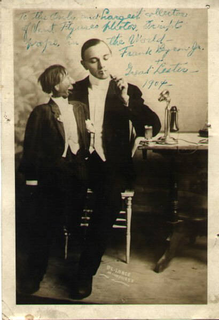
Ventriloquism, or ventriloquy, is a performance act of stagecraft in which a person creates the illusion that their voice is coming from elsewhere, usually a puppeteered prop known as a "dummy". The act of ventriloquism is ventriloquizing, and the ability to do so is commonly called in English the ability to "throw" one's voice.
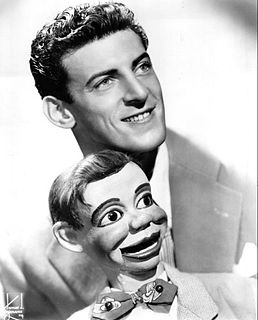
Paul Winchell was an American ventriloquist, comedian, actor, humanitarian and inventor, whose career flourished in the 1950s and 1960s. From 1950 to 1954, he hosted The Paul Winchell Show, which also used two other titles during its prime time run on NBC: The Speidel Show, and What's My Name? From 1965 to 1968, Winchell hosted the children's television series Winchell-Mahoney Time.

Wenceslao Moreno Centeno, known professionally as Señor Wences, was a Spanish ventriloquist and comedian. His popularity grew with his frequent television appearances on CBS's The Ed Sullivan Show during the 1950s and 1960s. Later, he became popular with another generation of fans on The Muppet Show.
Farfel the Dog is a hound dog ventriloquist's dummy created by Jimmy Nelson. The Farfel character is best known for television commercials for Nestlé's Quik which ran from 1953 to 1965. An original talking Farfel can be seen at the Chocolate Experience Museum, located in Burlington, Wisconsin.
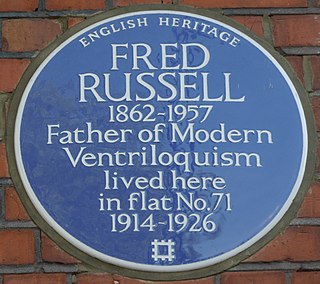
Thomas Frederick Parnell OBE, known professionally as Fred Russell, was an English ventriloquist. Usually credited as being the first to use a knee-sitting figure, he is known as "The Father of Modern Ventriloquism".
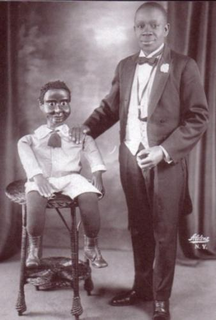
John Walcott Cooper, Jr. was an American ventriloquist, entertainer, and singer with the Southern Jubilee Singers. He was known as the "Black Napoleon of Ventriloquism" and also performed under the pseudonym Hezekiah Jones. Over the course of his lifetime Cooper was a member of the Negro Actors Guild of America, the Colored Vaudeville Benevolent Association, and the International Brotherhood of Ventriloquists.
Kevin Johnson is a professional ventriloquist, comedian, and magician.
Jay Johnson is an American ventriloquist and actor, best known for playing Chuck Campbell on Soap.

Harry Lester, born Maryan Czajkowski in Poland, best known by his stage name The Great Lester, was a seminal vaudeville ventriloquist.
Jerry Layne was the ventriloquist host of Puppet People, a TV series produced from 1973 to 1975 at CFCF-TV in Montreal and telecast on most CTV television network stations. He worked with his "friends" Lester and Herbie, puppets created for the show.

Terry Wayne Fator is an American ventriloquist, impressionist, stand-up comedian, and singer. Born in Dallas, Texas, he developed an interest in ventriloquism from a young age, developing both this and a talent for singing. After initially performing with two bands, Fator eventually conducted solo performances, combining ventriloquism and singing with comedy. He gained national recognition for his talent when he won the second season of America's Got Talent, which helped to boost his career.
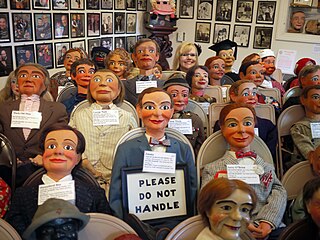
Vent Haven Museum is the world's only museum of ventriloquial figures and memorabilia. Its collection contains more than one thousand ventriloquist figures from twenty countries as well as hundreds of photographs and other pieces of memorabilia related to ventriloquism, including replicas of figures used by Edgar Bergen, Paul Winchell, and Shari Lewis, and authentic performance pieces used by Jimmy Nelson, Willie Tyler, Jay Johnson, Terry Fator, Jeff Dunham, and Darci Lynne. The museum is in Fort Mitchell, Kentucky, five miles south of Cincinnati. It opened in 1973.
Paul Zerdin is a British comedian and ventriloquist from London. He was the winner of the 10th season of America's Got Talent.
Yeshwant Keshav Padhye was the pioneering Indian Ventriloquist who started ventriloquism in India in the 1920s. He was also a puppeteer and maker.

A puppet is an object, often resembling a human, animal or mythical figure, that is animated or manipulated by a person called a puppeteer. The puppeteer uses movements of their hands, arms, or control devices such as rods or strings to move the body, head, limbs, and in some cases the mouth and eyes of the puppet. The puppeteer often speaks in the voice of the character of the puppet, and then synchronizes the movements of the puppet's mouth with this spoken part. The actions, gestures and spoken parts acted out by the puppeteer with the puppet are typically used in storytelling. Puppetry is a very ancient form of theatre which dates back to the 5th century BC in Ancient Greece. There are many different varieties of puppets, and they are made from a wide range of materials, depending on their form and intended use. They range from very simple in construction and operation to very complex.
James Edward Nelson was an American ventriloquist who appeared on television in the 1950s and 1960s. He is most famous for commercials for Nestlé chocolate featuring Farfel the Dog. He also hosted a children's show sponsored by Nestlé.
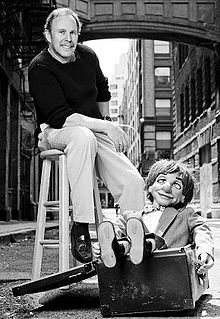
Kenny Warren is an American ventriloquist, comedian, and author. He has appeared on television shows such as What's My Line? and To Tell the Truth and also has performed with comedians such as Jerry Seinfeld and Rodney Dangerfield.
I'm No Dummy is a 2009 documentary film about ventriloquism directed by Bryan W. Simon, produced by Marjorie Engesser through Montivagus Productions. It premiered at the 2009 Seattle International Film Festival before being released theatrically in the United States by Salient Media and NBCUniversal in 2010.
Valentine Vox is a British born American ventriloquist and author known for his scholarly book on the history of ventriloquism, I Can See Your Lips Moving: the history and art of ventriloquism, which traces the practice back some three thousand years.

Frank Marshall was a professional ventriloquist dummy, marionette and Punch and Judy maker who created many of the most famous ventriloquist dummies used during the United States's vaudeville entertainment era through the Golden Age of Television. He is colloquially known as America's Geppetto. Among his creations were Jerry Mahoney and Knucklehead Smiff for ventriloquist Paul Winchell and Danny O’Day and Farfel the Dog for ventriloquist Jimmy Nelson.









